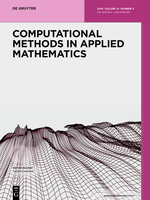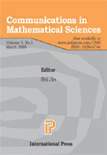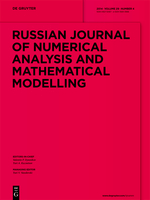
ESAIM-Mathematical Modelling and Numerical Analysis
Scope & Guideline
Exploring the Nexus of Theory and Application
Introduction
Aims and Scopes
- Mathematical Modelling:
The journal emphasizes mathematical modeling across various domains, including fluid dynamics, solid mechanics, and biological systems, showcasing how mathematical abstractions can represent real-world phenomena. - Numerical Analysis:
A core focus is on numerical methods for solving partial differential equations (PDEs) and other mathematical constructs, highlighting the development of new algorithms, techniques, and their convergence properties. - Computational Techniques:
Research on computational strategies, including finite element methods, discontinuous Galerkin methods, and hybrid approaches, is prevalent, aiming to improve accuracy and efficiency in simulations. - Stochastic Processes and Modelling:
The journal includes studies on stochastic models and their numerical approximations, emphasizing their application in areas like finance, physics, and biological systems. - Error Analysis and Stability:
A significant portion of the contributions focuses on error estimates, stability analysis, and adaptive methods, ensuring the reliability of numerical solutions in various contexts. - Multiscale and Multiphysics Problems:
The journal explores methodologies for addressing multiscale and multiphysics problems, integrating various physical processes and scales into coherent mathematical frameworks.
Trending and Emerging
- Advanced Discontinuous Galerkin Methods:
There is an increasing interest in advanced discontinuous Galerkin methods, reflecting their versatility and effectiveness in handling complex PDEs, particularly in fluid dynamics and wave propagation. - Data-Driven Approaches:
Emerging methods focused on data assimilation and machine learning techniques are gaining prominence, enabling researchers to leverage data for improved model accuracy and predictive capabilities. - Multiscale Modeling Techniques:
Research on multiscale modeling is on the rise, emphasizing the need to integrate phenomena occurring at different scales, particularly in materials science and biological systems. - Error Estimation and Adaptive Methods:
The trend towards robust error estimation and adaptive numerical methods is evident, with researchers focusing on techniques that ensure accuracy while optimizing computational resources. - Hybrid Numerical Approaches:
The adoption of hybrid numerical methods that combine various techniques (e.g., finite element and finite volume) is increasingly popular, as these methods offer greater flexibility and improved performance in simulations.
Declining or Waning
- Traditional Analytical Methods:
There is a noticeable reduction in papers focusing solely on traditional analytical solutions for PDEs, as researchers increasingly prefer numerical approaches that can handle complex, nonlinear systems. - Basic Finite Difference Methods:
The journal has seen fewer contributions centered on basic finite difference methods, likely due to the rise of more sophisticated numerical techniques like discontinuous Galerkin and spectral methods. - Static Models:
Research on static mathematical models is becoming less frequent, as the focus shifts towards dynamic and time-dependent models that better capture real-world phenomena. - Simplistic Stochastic Approaches:
There is a decline in simplistic stochastic modeling approaches, with a growing emphasis on more comprehensive stochastic frameworks that incorporate complex dependencies and interactions.
Similar Journals

Computational Methods in Applied Mathematics
Advancing Solutions Through Applied MathematicsComputational Methods in Applied Mathematics is a premier academic journal published by WALTER DE GRUYTER GMBH, based in Germany. With its ISSN 1609-4840 and E-ISSN 1609-9389, this journal serves as a crucial platform for the dissemination of cutting-edge research and innovations in the fields of Applied Mathematics, Computational Mathematics, and Numerical Analysis. Notably, it has been recognized in 2023 with a Q2 ranking in its category quartiles, marking it as a significant contributor in its discipline. Spanning from 2001 to 2024, it fosters interdisciplinary collaboration and exploration of computational methodologies that solve complex mathematical problems. Though it operates on a traditional access model, its relevance is underscored by its Scopus rankings, which place it among the notable leaders in its area. As a trusted source of scholarly articles, Computational Methods in Applied Mathematics is an essential resource for researchers, professionals, and students aiming to stay abreast of advancements and discussions that shape the future of applied mathematics.

Advances in Applied Mathematics and Mechanics
Fostering Collaboration in Applied Mathematics and MechanicsAdvances in Applied Mathematics and Mechanics is a premier academic journal published by GLOBAL SCIENCE PRESS that focuses on the latest research and innovative developments in the fields of applied mathematics and mechanical engineering. Since its inception in 2009, this journal has consistently contributed to the advancement of knowledge, garnering a respectable Q2 ranking in both Applied Mathematics and Mechanical Engineering categories, reflecting its significance in enhancing scientific discourse. With an impactful reach, as evidenced by its Scopus rankings, this journal hosts cutting-edge research, theoretical advancements, and practical applications that serve as invaluable resources for researchers, professionals, and students alike. While it operates under a subscription model, the accessibility of vital research findings is critical for driving innovation within these interrelated disciplines. The journal’s scope encompasses a broad range of topics, from computational methods to engineering applications, positioning it as a crucial platform for interdisciplinary collaboration and knowledge sharing in an ever-evolving academic landscape. For prospective authors and readers, Advances in Applied Mathematics and Mechanics stands as a key contributor to confidently navigating the nexus of applied mathematics and mechanics.

JSIAM Letters
Pioneering Insights in Industrial Applications of MathematicsJSIAM Letters, with ISSN 1883-0609 and E-ISSN 1883-0617, is an esteemed journal published by the Japan Society of Industrial and Applied Mathematics (JSIAM). Focusing on the latest advancements in the field of industrial and applied mathematics, this journal serves as a vital platform for researchers, professionals, and students to disseminate their findings and exchange innovative ideas. Although it currently does not offer Open Access options, JSIAM Letters maintains a strong reputation for high-quality, peer-reviewed articles that contribute to the growth and application of mathematical techniques in various industrial contexts. With a commitment to fostering collaboration within the mathematical community, JSIAM Letters plays a crucial role in bridging the gap between theoretical research and practical application, making it indispensable for anyone interested in the intersection of math and industry.

ADVANCES IN COMPUTATIONAL MATHEMATICS
Pioneering the Future of Mathematical InnovationADVANCES IN COMPUTATIONAL MATHEMATICS, published by Springer, is a leading international journal dedicated to the dynamic and rapidly evolving fields of Applied Mathematics and Computational Mathematics. With an impressive Q1 ranking in both categories as of 2023, the journal serves as a vital platform for researchers and professionals to disseminate innovative methodologies and computational techniques that address complex mathematical challenges. Operating since 1993 and continuing to contribute substantially to the academic landscape through 2024, it boasts a robust reputation within the mathematics community, underscored by its Scopus rankings—#230 out of 635 in Applied Mathematics and #80 out of 189 in Computational Mathematics. This journal, based in the Netherlands, emphasizes cutting-edge research while offering a wealth of access options to facilitate scholarly communication. As such, ADVANCES IN COMPUTATIONAL MATHEMATICS stands as an essential resource for anyone interested in the forefront of computational techniques and mathematical theory.

Communications in Mathematical Sciences
Fostering Excellence in Mathematical ResearchCommunications in Mathematical Sciences is a prestigious journal published by INT PRESS BOSTON, INC, dedicated to advancing the field of mathematical sciences through the dissemination of high-quality research. Since its inception in 2003, the journal has established itself as a key platform for scholars in both applied and theoretical mathematics, evidenced by its impressive rankings, with a Q2 designation in Applied Mathematics and a Q1 status in Miscellaneous Mathematics categories as of 2023. Although not an open-access journal, it provides comprehensive access to groundbreaking studies that span a wide array of topics within mathematical sciences, making it invaluable for researchers, professionals, and students alike. The journal's strong performance metrics, including a Scopus rank that places it in the 64th and 38th percentiles for General and Applied Mathematics, respectively, highlight its influence and significance within the academic community. With an optimistic convergence towards future advancements by 2024, Communications in Mathematical Sciences continues to play a vital role in the growth and evolution of mathematical inquiry.

DOKLADY MATHEMATICS
Shaping the Future of Mathematics Through Rigorous ResearchDOKLADY MATHEMATICS is a prestigious journal published by MAIK NAUKA/INTERPERIODICA/SPRINGER, recognized for its significant contributions to the field of mathematics. Since its inception in 1996, the journal has been delivering high-quality research articles, fostering advancement in diverse areas of mathematical sciences. With an ISSN of 1064-5624 and an E-ISSN of 1531-8362, it has established itself within the academic community and holds a respectable Q2 quartile ranking in Mathematics (miscellaneous), indicating its relevance and influence. Although it does not operate under an open-access model, the journal remains an invaluable resource for researchers, professionals, and students, propelling innovation and scholarship in mathematics until 2024. The Scopus ranking situates it at rank #254 out of 399 in the Mathematics General category, showcasing its position within the broader landscape of mathematical journals. This journal is essential for those aiming to stay abreast of the latest findings and theoretical advancements in the mathematics domain.

NUMERICAL ALGORITHMS
Pioneering research in applied numerical methodologies.NUMERICAL ALGORITHMS, published by Springer, is a leading journal in the field of Applied Mathematics, distinguished by its relevant research publications since 1991. With an ISSN of 1017-1398 and E-ISSN 1572-9265, this journal ranks in the Q2 category of Scopus for Applied Mathematics, placing it in the top 22% of its field based on the latest 2023 rankings. The journal strives to disseminate innovative algorithms and methodologies that impact both theoretical developments and practical applications. Although currently not an open-access journal, it offers widespread access through institutional subscriptions, making it an essential resource for researchers, practitioners, and students committed to advancing numerical techniques and their applications in complex problem-solving scenarios. Located in Dordrecht, Netherlands, NUMERICAL ALGORITHMS aims to foster collaboration and knowledge exchange among the global mathematical community, providing a pivotal platform for high-quality research and critical discourse.

International Journal of Numerical Analysis and Modeling
Advancing the Frontiers of Numerical AnalysisThe International Journal of Numerical Analysis and Modeling, published by ISCI-INST SCIENTIFIC COMPUTING & INFORMATION, is a leading platform for research in the field of numerical analysis. With an ISSN of 1705-5105 and an E-ISSN of 1705-5105, this esteemed journal has been disseminating rigorous and innovative studies since its inception in 2004. Covering a diverse range of topics within numerical analysis, it has successfully positioned itself in Q2 of the 2023 category quartiles and ranks 46th out of 88 in its Scopus classification, showcasing its relevance and impact within the academic community. Operating under an open access model, it ensures that research findings are accessible to a global audience, fostering collaboration and knowledge exchange. Based in Canada, this journal not only highlights advancements in computational methodologies but also addresses real-world applications, bridging theoretical frameworks with practical solutions. Researchers, professionals, and students alike will find valuable insights and up-to-date contributions in this crucial field of study.

RUSSIAN JOURNAL OF NUMERICAL ANALYSIS AND MATHEMATICAL MODELLING
Fostering Excellence in Numerical Research and SimulationRUSSIAN JOURNAL OF NUMERICAL ANALYSIS AND MATHEMATICAL MODELLING, published by WALTER DE GRUYTER GMBH in Germany, is a vital resource for researchers and practitioners in the fields of numerical analysis, mathematical modeling, and computational mathematics. With an ISSN of 0927-6467 and an E-ISSN of 1569-3988, this journal has been disseminating significant findings since its inception in 1986 and continues to do so into 2024. Despite its current position in Q4 category quartiles and modest Scopus rankings, it provides a platform for innovative research that contributes to the evolution of modeling and simulation techniques. The journal is committed to fostering an understanding of complex numerical methods and their applications across various scientific disciplines. Although it does not provide Open Access options, it remains a key publication that underscores the importance of rigorous mathematical analysis and its practical implications in today's technology-driven world.

JOURNAL OF COMPUTATIONAL AND APPLIED MATHEMATICS
Empowering Innovation Through Computational InsightsJOURNAL OF COMPUTATIONAL AND APPLIED MATHEMATICS, published by Elsevier, stands as a premier platform for researchers and practitioners in the fields of applied and computational mathematics. With an impressive convergence history from 1975 to 2025, this journal has established itself as a crucial reference point for innovative mathematical theories, methodologies, and applications. Holding a distinguished position in Scopus rankings—#85 out of 635 in Applied Mathematics and #36 out of 189 in Computational Mathematics—it operates in the highly competitive Q2 quartile for both disciplines as of 2023. Although currently not designated as an open-access journal, it remains widely respected for its rigorous peer-review process and high-quality research contributions. Researchers and professionals seeking to advance their work and engage with cutting-edge developments will find this journal an invaluable resource, fostering a deeper understanding and collaboration within the mathematical community.